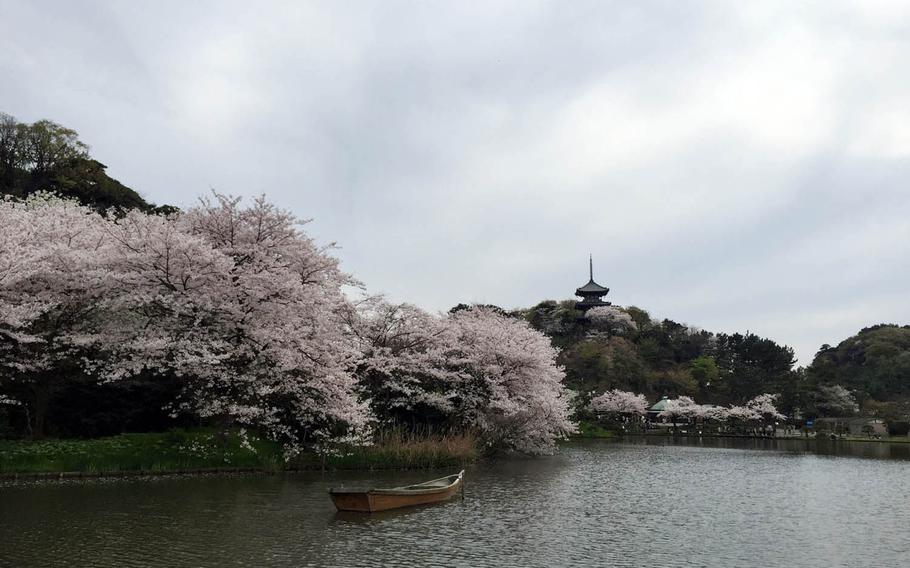
A rowboat rests on a lake near the main entrance to Sankeien in Yokohama. (Erik Slavin/Stars and Stripes)
Cherry blossom mania descends on Japan in the spring, fueling a week or two of pink-tinged scenery, crowded picnics and blurry, close-up flower photos on social media websites.
It’s fun, but think of sakura more as the main event among the Kanto area’s many blooms.
One of the best places in the region to experience all four seasons is Sankeien, a 43-acre expanse of gardens, water and historic buildings in Yokohama.
Sankeien opened in 1906 and, with a few heavy doses of renovation, survived major earthquakes and WWII to become one of Japan’s largest collection of culturally important architecture.
The three-story Pagoda of Old Tomyoji, built in 1457 and moved from Kyoto Prefecture, overlooks structures ranging from teahouses to farmhouses, as well as living space for Sankeien’s founder, a wealthy silk trader named Sankei Hara.
Hara spent decades adding to Sankeien, and his project continued when the Sankeien Hoshokai Foundation, the park’s current owner, took over in 1953.
Sankeien is split into two main areas: the outer garden, which features a large pond and places to eat and drink, and the inner garden, a more compact space where Hara’s family once lived.
The outer garden near the pond is where most of the photography happens. The pagoda is a steep but relatively short climb.
The outer garden also includes the Yanohara house, a two-story wooden home moved here in 1960. The home includes original farm equipment, historic kitchen, a fireplace and large, tatami-matted living rooms.
The inner garden is shadier and, at least on a less crowded weekday, more serene. It’s there you’ll find a small bamboo forest, wisteria and plum blossoms.
There is something different going on each month at the park to earn repeat business, and mid-year is a particularly good time to visit. From May 28 to June 5, the park opens up at night for firefly viewing www.sankeien.or.jp/en-event/10.html. Beginning May 22, Sankeien shows off a collection of azalea bonsai, and offers advice on how to grow your own miniature trees.
slavin.erik@stripes.com Twitter:@eslavin_stripes
DIRECTIONS: From JR Negishi Station, take the 58, 99 or 101 buses from the No. 1 bus stop and get off at Honmoku. Cross the street and walk toward the park, about seven minutes. Coming by car on the expressway, get off at the Sankeien ramp and follow the road until Honmoku Motomachi Iriguchi; turn left. For more directions, go to: www.sankeien.or.jp/pdf/guidemap_english.pdf
TIMES: Daily, 9 a.m. to 5 p.m.; last entry at 4:30 p.m.
COSTS: 500 yen for adults, 200 yen for elementary school-aged children and younger. Parking is 500 yen up to two hours; 100 yen each additional 30 minutes or 1,000 yen for a full day. Private lots in the neighborhood are also available.
INFORMATION: 58-1 Honmokusannotani, Naka-ku, Yokohama, Kanagawa 231-0824; www.sankeien.or.jp/en-about/index.html; 045-621-0634/0635